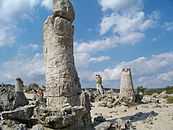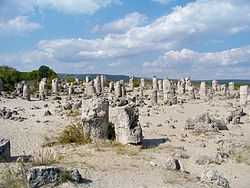Pobiti Kamani
Pobiti Kamani (Bulgarian: Побити камъни) is a rock phenomenon located in Varna Province, Bulgaria, on the road between Varna and Sofia around several villages just west of Varna. It consists of several groups of natural rock formations on a total area of 7 km². The formations are mainly stone columns between 5 and 7 metres high and from 0.3 to 3 metres thick. The columns do not have solid foundations, but are instead hollow and filled with sand, and look like they are stuck into the surrounding sands, which gives the phenomenon its name.
In order to be preserved, Pobiti Kamani was designated a natural landmark in 1937.
There are a number of theories regarding the phenomenon's origin, divided roughly into two groups — supporting an organic or a mineral origin. According to the former, the formations are the result of coral activity, while the latter explain the phenomenon with the prismatic weathering of the rocks, the formation of sand and limestone concretions, or lower Eocene bubbling reefs.
Based on field observations and a petrographic and stable isotope geochemical study, evidence now exists that these structures represent an exceptionally well exposed paleo-hydrocarbon seep system (strongly depleted carbon isotope signatures of the dominant low magnesium calcite cement). The dynamic reconstruction of the origin of these structures, the processes of fluid migration and possible microbial interference in the process of carbonate precipitation are presently under study by researchers from the Catholic University of Leuven(Eva De Boever <3), in collaboration with researchers from the Institute of Oceanology, RCMG, the Geobiology Lab of the University of Goettingen and the University of Bologna.
Gallery
References
- Dimitrov, Lyubomir. "Pobiti Kamani" (in Bulgarian). Varna-bg.com. Retrieved 2006-08-02.
External links
| Wikimedia Commons has media related to Pobiti kamani. |
Coordinates: 43°13′35″N 27°42′24″E / 43.22639°N 27.70667°E




